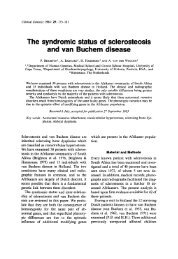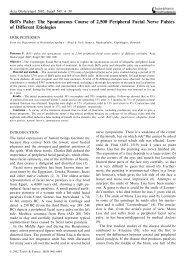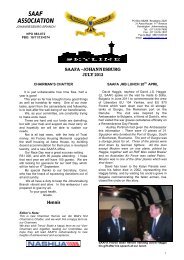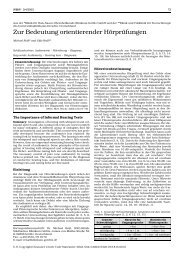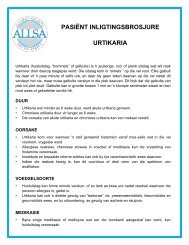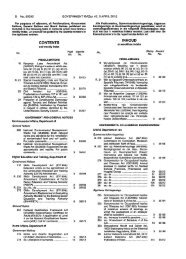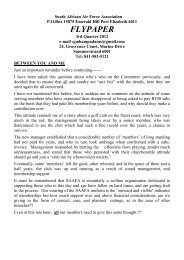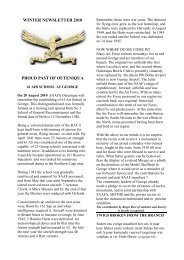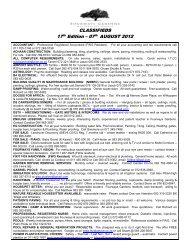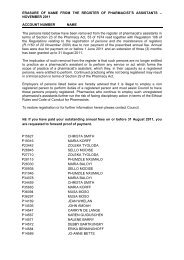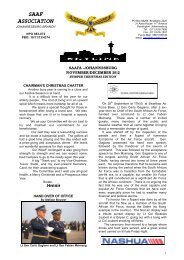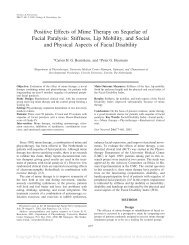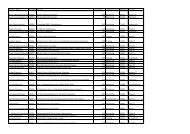Republic of Botswana - Admin
Republic of Botswana - Admin
Republic of Botswana - Admin
You also want an ePaper? Increase the reach of your titles
YUMPU automatically turns print PDFs into web optimized ePapers that Google loves.
Guideline should be made available on MoH home page<br />
<strong>Republic</strong> <strong>of</strong> <strong>Botswana</strong><br />
MINISTRY OF HEALTH<br />
Private Bag 0038/ Private Bag 00355, GABORONE. BOTSWANA<br />
Tel: + (267) 3632064/030/383/ 376/378 Fax: +(267) 39170172<br />
Drugs Regulatory Unit<br />
NOVEMBER 2008<br />
1
CONTENTS<br />
Introduction……………………………………………….<br />
Definition and Terminologies……………………………<br />
Rationale <strong>of</strong> ADR Monitoring……………………………<br />
Pharmacovigilance……………………………………….<br />
Reporting <strong>of</strong> ADR…………………………………………<br />
Reporting by Whom?..................................................<br />
What to Report?............................................................<br />
Which to Report?..........................................................<br />
When to Report?..........................................................<br />
How to Report?............................................................<br />
Follow-Up <strong>of</strong> reports……………………………………..<br />
Stimulation <strong>of</strong> Reporting………………………………...<br />
Directions for completing the ADR Reporting Form….<br />
Evaluation <strong>of</strong> the ADR Report………………………….<br />
Communications…………………………………………<br />
Duties and Responsibilities…………….......................<br />
Promotion <strong>of</strong> ADR Reporting…………………………..<br />
Latin Terms and Abbreviations…………………………<br />
Glossary…………………………………………………..<br />
2
I. INTRODUCTION:<br />
Since drugs are intended to relieve suffering, patients find it peculiarly <strong>of</strong>fensive that drugs<br />
cause disease, which are <strong>of</strong>ten unexpected. A simple account <strong>of</strong> unwanted effects as<br />
inherent to the drug is erroneous. In addition to the inherent factors, adverse effects are<br />
promoted or even caused by numerous non-drug factors.<br />
Adverse Drug Reaction (ADR) reporting and monitoring system is important to collect,<br />
collate and analyze data as a means <strong>of</strong> establishing new knowledge and generate early<br />
signals <strong>of</strong> possible drug complications not reported through clinical trials. Out put from such<br />
adverse drug reaction-reporting systems compliment the information appearing in the<br />
published literature and from other studies.<br />
The drug administration and control proclamation gives the Drug <strong>Admin</strong>istration and<br />
Control Authority [explain what this control authority is] the mandate to carryout postmarketing<br />
surveillance in order to ensure the safety, efficacy and quality <strong>of</strong> drugs that are<br />
put into use. It also gives the authority the power to ban the use, or revoke the registration,<br />
<strong>of</strong> a drug that was put into use when, later on proved to be ineffective or its risks out weights<br />
its benefits.<br />
Collection, tabulation, and analysis <strong>of</strong> suspected adverse reaction on the national level is <strong>of</strong><br />
paramount importance. Therefore, the authority has organized Adverse Drug Reaction<br />
monitoring (ADR) and promotion control division under the Planning, Drug information<br />
establishment and dissemination Department.(confusing)<br />
The division has prepared an easy to fill in reporting form with prepaid postage and it will be<br />
available for all health pr<strong>of</strong>essionals at each health institutions for voluntary and<br />
spontaneous reporting. The success <strong>of</strong> the ADR monitoring depends on the cooperation <strong>of</strong><br />
the (health care)medical pr<strong>of</strong>essionals in reporting suspected adverse reactions, especially<br />
to new drugs.<br />
This guideline is prepared with the intention to make the reporting <strong>of</strong> ADR consistent,<br />
regular and complete. Hence, it gives information on what, when, how and whom to report.<br />
II. DEFINITIONS AND TERMINOLOGIES:<br />
3
1. Drug or Medicine: means any substance or combination <strong>of</strong> substances used or<br />
purporting to be suitable for use or manufactured or sold for use in the diagnosis,<br />
treatment, alleviation, modification or prevention <strong>of</strong> disease, illness, abnormal physical<br />
or organic condition or the symptoms there<strong>of</strong> restoring, correcting or modifying any<br />
somatic or psychic or organic condition.<br />
2. Side effects: any unintended effect <strong>of</strong> a pharmaceutical product occurring at doses<br />
normally used in humans which is related to the pharmacological properties <strong>of</strong> the drug.<br />
3. Adverse Drug Reactions: [ADR]<br />
Noxious and unintended reaction to drugs that occurs at a dose used in human for<br />
diagnosis, treatment or prophylaxis <strong>of</strong> disease or for the restoration, correction or modification <strong>of</strong><br />
physiological function.<br />
An ADR is characterized by the occurrence <strong>of</strong> a suspected causal relationship between the drug<br />
and the reaction, as determined by the reporter or a reviewing health care pr<strong>of</strong>essional. The<br />
reaction means that a causal relationship between the medicinal product and an adverse event<br />
is at least a reasonable possibility.<br />
4. Signal: refers to “reported information on a possible casual relationship between an adverse<br />
event and a drug, the relationship being unknown or incompletely documented previously”.<br />
Usually more than one report is required to generate a signal depending on the seriousness <strong>of</strong><br />
the event and the quality <strong>of</strong> the information.<br />
5. Applicant: means a company or individual who applies for the registration <strong>of</strong> a product or a<br />
medicine or who has applied for the use <strong>of</strong> a medicine or product in a clinical trial in <strong>Botswana</strong>.<br />
6. Clinical trial: a systematic study in human beings or animals in order to establish the<br />
efficacy <strong>of</strong> or to, or to discover the or verify the effects or adverse reactions a medicine or<br />
product and includes a study <strong>of</strong> the absorption, distribution, metabolism and excretion <strong>of</strong><br />
medicines.<br />
7. Drug administration and Control authority<br />
??<br />
4
8. Consumer:<br />
A person who is not a Health Care Pr<strong>of</strong>essional such as a patient, lawyer, friend<br />
orrelative / parents/ children <strong>of</strong> a patient.<br />
9. Health care pr<strong>of</strong>essional:<br />
Defined as medically qualified persons, such as medical practioners,<br />
pathologists, dentists, pharmacists’ nurses, coroners, veterinarians and paraveterinary<br />
pr<strong>of</strong>essionals including veterinary nurses and animal health<br />
technicians.<br />
10. Pharmacovigilance: Pharmacovigilance is concerned with the detection, assessment,<br />
prevention <strong>of</strong> adverse reactions <strong>of</strong> drugs and any drug related problems.<br />
11. Drug/Medicine Interactions<br />
Any drug interaction, which results in an adverse reaction, should be reported as<br />
an adverse reaction in the prescribed manner.<br />
12. ADR Case Report : A notification relating to a patient with an adverse medical event (or<br />
laboratory test abnormality) suspected to be induced by a medicine.<br />
13. Lack <strong>of</strong> Efficiency: Defined as a failure to produce the expected pharmacological action.<br />
III. Rationale <strong>of</strong> ADR monitoring<br />
Reporting ADR is essential to obtain the necessary information on safety<br />
<strong>of</strong> different subgroups such as children, pregnant women, elderly and patients with complicated<br />
disease or multiple conditions, which are not normally exposed during the clinical trial.<br />
It is also essential for the early detection <strong>of</strong> unknown reactions and interactions between<br />
medicines, detection <strong>of</strong> increase in ADR frequency, identification and quantification <strong>of</strong> risk<br />
factors, detection and removal <strong>of</strong> counterfeited and substandard drugs in the market.<br />
IV. PHARMACOVIGILANCE:<br />
5
1. AIMS:<br />
• The rational and safe use <strong>of</strong> medical drugs<br />
• To increase the trust <strong>of</strong> patient on medication and health care personnel<br />
• Assessment and communication <strong>of</strong> the risks and benefits <strong>of</strong> drugs in the market<br />
• To reduce the cost <strong>of</strong> treatment<br />
• To increase patient compliance<br />
• To educate and inform patients<br />
Through<br />
• Early detection <strong>of</strong> unknown adverse reactions and interactions<br />
• Detection <strong>of</strong> increase in frequency <strong>of</strong> unknown adverse reaction<br />
• Identification <strong>of</strong> risk factors and possible mechanisms underlying adverse reactions<br />
• Estimation and quantification <strong>of</strong> benefits and risks<br />
• Distribution <strong>of</strong> information needed to improve drug prescribing and regulation.<br />
2. IMPORTANCE OF PHARMACOVIGILANCE:<br />
Pharmacovigilance is important or required because,<br />
• The information collected during the pre-marketing phase <strong>of</strong> a drug is inevitably<br />
incomplete with regard to possible adverse reactions.<br />
• Tests in animals are insufficiently predictive <strong>of</strong> human safety.<br />
• During clinical trials, the patients selected are limited in number, the conditions <strong>of</strong> use<br />
differ from those in clinical practice and the duration <strong>of</strong> trials is limited.<br />
• Information about rare but serious adverse reactions, chronic toxicity, use in special<br />
groups (like children, elderly, pregnant women etc) or drug interactions is <strong>of</strong>ten<br />
incomplete or not available.<br />
Pharmacovigilance is needed in every country, because there are differences in efficacy<br />
between populations (even regions within the countries) and also in occurrence <strong>of</strong> adverse<br />
reactions and other drug-related problems. This may be due to differences in<br />
Drug distribution and use (e.g. indications, dose, availability etc)<br />
Genetics, diet, traditions <strong>of</strong> the people<br />
Pharmaceutical quality and composition (excipients) <strong>of</strong> locally produced<br />
pharmaceutical products.<br />
6
The use <strong>of</strong> herbal medicines which may pose special toxicological problems<br />
when used alone or in combination with other drugs.<br />
Data derived from within the country or region may have greater relevance and educational<br />
value and can encourage national regulatory decision-making. Information obtained in a certain<br />
country (e.g. the country <strong>of</strong> origin <strong>of</strong> the drug) may not be relevant to other parts <strong>of</strong> the world,<br />
where circumstances may be different. When information from a region itself is not available it<br />
may take longer before a problem becomes known to drug regulatory authorities, physicians,<br />
pharmacists, patients and pharmaceutical companies.<br />
On the other hand, international monitoring centers such as the WHO International Drug<br />
Monitoring Program may provide information on possible safety issues which may not yet have<br />
emerged within the country’s data. Pharmacovigilance is needed for the prevention <strong>of</strong> druginduced<br />
human suffering and to avoid financial risks associated with unexpected adverse<br />
effects.<br />
In conclusion, medicines used in the country need continuous monitoring to assess its benefits<br />
and adverse effects.<br />
V. REPORTING OF ADVERSE DRUG REACTIONS<br />
1. ADR Case Report<br />
An ADR case report should (as a minimum to aim at) contain information on the following<br />
entries:<br />
The patient: Age, sex and brief medical history (when relevant). In some countries<br />
ethnic origin may need to be specified.<br />
Adverse event: Description (nature, localization, severity, characteristics), results <strong>of</strong><br />
investigations and tests, start date, course and outcome.<br />
Suspected drug(s): Name (brand or ingredient name + manufacturer), dose, route,<br />
start/stop dates, indication for use (with particular drugs, e.g. vaccines, a batch number<br />
is important).<br />
All other drugs used (including self-medication): Names, doses, routes, start/stop dates.<br />
Risk factors (e.g. impaired renal function, previous exposure to suspected<br />
drug, previous allergies, social drug use).<br />
7
Name and address <strong>of</strong> reporter (to be considered confidential and to be used only for<br />
data verification, completion and case follow-up).<br />
Reporting procedure should be easy and postage charges be kept as cheap as possible.<br />
Special free-post or business reply reporting forms, can be distributed throughout the target<br />
area to healthcare pr<strong>of</strong>essionals at regular intervals (for example, four times a year). ADR<br />
reporting forms should be available on the website and also on the MEDITEC which should be<br />
networked with the Pharmacovigilance department.<br />
2. RESPONSIBLITY OF REPORTING ADRs<br />
Health pr<strong>of</strong>essionals working in healthcare facilities are the preferred source <strong>of</strong> information in<br />
Pharmacovigilance. E.g. family practitioners, doctors, specialists pharmacists, dentists,<br />
midwives, nurses and other health workers who may also<br />
administer or prescribe drugs should report relevant experiences.<br />
In addition pharmacists and nurses can play an important role in the stimulation <strong>of</strong><br />
reporting and in the provision <strong>of</strong> additional information (for example, on co-medication<br />
and previous drug use). If adverse reactions are reported directly by patients to the national or<br />
local centre, it is useful to consider the possibility <strong>of</strong> communication with their physicians for<br />
additional information and data verification.<br />
3. RESPONSIBILITY OF PHARMACEUTICAL MANUFACTURERS<br />
Pharmaceutical manufacturers being primarily responsible for the safety <strong>of</strong> their products, have<br />
to ensure that suspected adverse reactions to their products are reported to the regulatory<br />
authority. The applicant for a medicine or pharmaceutical product is legally responsible for the<br />
reporting <strong>of</strong> the all known adverse drug reactions <strong>of</strong> the product or medicine for which the<br />
applicant is responsible.<br />
Table moved down<br />
4. GENERAL DETAILS OF REPORTING<br />
In the early stages <strong>of</strong> development <strong>of</strong> any Pharmacovigilance system, reports on all suspected<br />
adverse reactions whether known or unknown, serious or mild are useful, because it is<br />
necessary to create a notification culture in which the instinctive response to any suspected<br />
adverse drug reaction is to report it.<br />
8
Healthcare pr<strong>of</strong>essionals need to learn how and what to notify, and the staff <strong>of</strong> the<br />
Pharmacovigilance centre need to be competent in assessment, coding and interpretation <strong>of</strong> the<br />
reports.<br />
In established Pharmacovigilance systems it is a common practice to request the reporting <strong>of</strong> all<br />
suspected reactions, including minor ones for new drug products.<br />
For established? drugs (confusing, Is it market experienced drugs?) the reporting <strong>of</strong> serious or<br />
unusual suspected adverse reactions is <strong>of</strong> particular importance, whereas known and minor<br />
reactions are <strong>of</strong> less interest. If an increased frequency <strong>of</strong> a given reaction is suspected this is<br />
also a reason for reporting.<br />
Although pharmacovigilance is primarily concerned with pharmaceutical products<br />
(including radiologic contrast media, vaccines and diagnostics), adverse reactions<br />
associated with drugs (They may not call drug, but supplements, clarify) used in<br />
traditional/alternative medicines (e.g. herbal remedies) should also be considered. Special fields<br />
<strong>of</strong> interest includes drug abuse and drug use in pregnancy (teratogenicity) and lactation.<br />
Also, adverse reactions to cosmetics need to be reported, especially when they contain<br />
obsolete, toxic or undisclosed proprietary ingredients (e.g. mercury compounds or corticoids in<br />
bleaching creams).<br />
Over Dosage:<br />
Reports <strong>of</strong> overdose should be submitted only when an adverse reaction was associated with<br />
the overdose. Suspected adverse reactions associated with an overdose should be reported as<br />
other reactions. This should include reports that indicate that taking <strong>of</strong> the suspected medicine<br />
led to suicidal intention and subsequent overdose <strong>of</strong> the suspected medicine or other<br />
medications.<br />
Teratogenicity and Congenital Anomalies:<br />
For reports on Teratogenicity and congenital anomalies:<br />
Indicate age and sex <strong>of</strong> the infant<br />
Follow-up reports for the infant should be considered - a follow-up to the initial report<br />
The birth date or the date pregnancy was terminated should be the event onset date<br />
9
Include date and or duration <strong>of</strong> in utero exposure where possible<br />
Any adverse reaction experienced by the mother must be considered a new initial case<br />
report on a separate report form<br />
Product Details:<br />
If an adverse event is suspected to be related to a product defect, it should be reported in the<br />
same manner as a suspected adverse reaction. The lot number <strong>of</strong> the suspected medicine<br />
should be included in the report. Applicants should inform whether the implicated products have<br />
been tested for product quality and what (if any) corrective actions are being/have been taken.<br />
Drug Interactions:<br />
Any drug interaction which results in an adverse reaction should be reported as an adverse<br />
reaction in the prescribed manner.<br />
Another Applicant’s Product:<br />
If the pharmaceutical company receives a report <strong>of</strong> a suspected adverse reaction to a medicine<br />
marketed by another applicant, such a report should promptly be forwarded to the applicant.<br />
Such reports should not be reported to the Authority by the applicant to whom the event was<br />
originally reported.<br />
When serious, unexpected reactions are observed for another applicant’s medicine, used during<br />
the conduct <strong>of</strong> clinical trial, reports should be submitted directly to the authority by the applicant<br />
conducting the study.<br />
Confidentiality:<br />
Strict confidentiality will be maintained by the Authority regarding the identities <strong>of</strong> the patient and<br />
the reporter.<br />
Lack <strong>of</strong> Efficiency Reports:<br />
Lack <strong>of</strong> Efficiency applies to the medicines registered in the country. The lot number <strong>of</strong> the<br />
suspected medicine should be included in the report. If the report <strong>of</strong> “Lack <strong>of</strong> Efficiency” is for an<br />
unapproved indication, the event is still reportable.<br />
The Pharmacovigilance centre also monitors adverse reactions related to medical, surgical<br />
devices, equipment and consumables until an institution or body specifically takes this role.<br />
10
Pharmacovigilance and poison control are closely related activities, since the problems<br />
encountered with accidental or intentional overdose may cast doubt on the safety <strong>of</strong> a<br />
product..<br />
The spontaneous reporting system <strong>of</strong> adverse reactions is by far the most effective method <strong>of</strong><br />
gathering such information. It is fairly efficient in detecting truly serious reactions. It appears that<br />
serious problems are reported early and that warnings are issued timely. When there is an<br />
adverse reaction to drugs the reporting form should be completed by the concerned health<br />
pr<strong>of</strong>essional and sent to the ADR monitoring division.<br />
Note: The reporter does not need to prove that there is a casual association between drug and adverse reaction.<br />
Therefore, uncertainty <strong>of</strong> the cause and effect relationship should not be reason for not reporting.<br />
WHAT TO REPORT?<br />
OF WHICHTO REPORT?<br />
REPORT EVEN IF<br />
SEND REPORT TO<br />
• All suspected reactions<br />
• Lack <strong>of</strong> effect<br />
• Counterfeiting<br />
• Resistance to treatment<br />
• Interaction with food, other medications or Herbal<br />
products<br />
• Dependence and abuse<br />
• Allopathic medicines including OTC<br />
• Traditional Medicines<br />
• Biologicals like vaccines and sera<br />
• Cosmetics<br />
• Medical,Surgical, Equipement and consumables<br />
• You’re not certain the product caused adverse event<br />
• You don’t have all the details as soon as possible<br />
Drug Regulatory Unit<br />
Ministry <strong>of</strong> Health<br />
P/Bag 0038, Gaborone<br />
<strong>Botswana</strong><br />
Tel: +267- 3632383<br />
Fax: +267- 3170169<br />
Table1: Quick Reference for Reporting<br />
11
5. REPORTING DURATION OF AN ADR<br />
Applicant should report all non-serious, suspected and unexpected adverse reactions to the<br />
ADR monitoring division as soon as possible within 15 calendar days after first knowledge<br />
by the applicant. Delay in reporting will make reporting inaccurate and unreliable. Reporting<br />
while the patient is still in the health institution will give chance to the reporter to clear any<br />
ambiguity by re-questioning or examining the patient.<br />
REPORTING REQUIREMENTS FOR APLLICANTS:<br />
Table 2: Post-Registration ADR Reports (registered medicinal products and exempted<br />
complementary medicines and products)<br />
Type <strong>of</strong> ADR report Time frame for reporting Format<br />
Local Reports (spontaneous/published/study):<br />
• Serious (expected and unexpected)<br />
• Non serious (unexpected)<br />
• Non serious (expected)<br />
Foreign Reports<br />
(spontaneous/published/ study):<br />
• Serious<br />
15 days<br />
As above<br />
As above<br />
ADR form or other<br />
internationally accepted<br />
format<br />
As above<br />
As above (more so for<br />
HIV/AIDS, malaria and TB<br />
30 days As appropriate<br />
Notification <strong>of</strong> Change in Nature, Severity or<br />
Frequency or Risk factors<br />
15 days Detailed report<br />
(including publications)<br />
New information impacting on benefit-risk pr<strong>of</strong>ile<br />
<strong>of</strong> product including international regulatory<br />
decisions<br />
3 days Detailed report (including<br />
publications)<br />
Table 3: Pre-Registration ADR/ADE reports (i.e. unregistered medicines being used approved<br />
clinical trials<br />
TYPE OF ADR REPORT<br />
TIME FRAME FOR<br />
REPORTING<br />
FORMAT<br />
12
Local Reports:<br />
• Fatal or life-threatening (unexpected)<br />
• Other serious (unexpected)<br />
All (local & foreign) reports:<br />
• Serious (unexpected and expected)<br />
events<br />
7+8**<br />
15 days<br />
15 days<br />
ADR form or other<br />
internationally accepted format<br />
As above<br />
ADR form or other<br />
internationally accepted format<br />
• Non-serious unexpected and expected<br />
reactions<br />
Notification <strong>of</strong> Change in Nature, Severity<br />
or Frequency <strong>of</strong> Risk factors<br />
15 days<br />
15days<br />
ADR form or other<br />
internationally accepted format<br />
Detailed report<br />
New information impacting on risk-benefit<br />
pr<strong>of</strong>ile <strong>of</strong> product or conduct <strong>of</strong> trial<br />
3 days Detailed report<br />
6. PERIODIC SAFETY UPDATE REPORTS (PSURs):<br />
PSURs should only be submitted in the following situations:<br />
Whenever requested by the authority<br />
When the submission <strong>of</strong> PSURs is a condition <strong>of</strong> registration for a new medicinal<br />
product. These PSURs must be submitted within 30 calendar days <strong>of</strong> initial receipt by<br />
the applicant from the parent company.<br />
As part <strong>of</strong> a part <strong>of</strong> a submission for a package insert amendment when the PSUR<br />
contains information supporting the amendment.<br />
When a new medicinal product is submitted to the Authority for registration and where<br />
the product has already been marketed elsewhere, PSURs should be submitted to the<br />
Authority within 30 calendar days during the evaluation period prior to registration.<br />
7. FOLLOW-UP OF REPORTS:<br />
After Initial receipt <strong>of</strong> an adverse reaction report, a notice <strong>of</strong> acknowledgement will be sent to<br />
the applicant quoting the number assigned to the case report. Any follow-up correspondence<br />
from the applicant, relating to the same case report should be cross-referenced to the assigned<br />
database number or to an appropriate unique number assigned by the applicant (relating<br />
specifically to the initial notification). This is the only reliable way to minimize the duplication<br />
<strong>of</strong> reports submitted by applicants.<br />
13
9. STIMULATION OF REPORTING<br />
The reporting <strong>of</strong> adverse reactions needs continuous stimulation. It is important to achieve the<br />
development <strong>of</strong> a positive attitude towards pharmacovigilance among healthcare pr<strong>of</strong>essionals<br />
so that adverse reaction reporting becomes an accepted and understood outline. In summary,<br />
the following may stimulate reporting:<br />
easy access to pre-paid reporting forms and other means <strong>of</strong> reporting<br />
acknowledging the receipt <strong>of</strong> adverse drug reaction reports by personal letter or phone<br />
call<br />
providing feedback to reporters in the form <strong>of</strong> articles in journals, adverse drug<br />
reaction bulletins or newsletters<br />
participation <strong>of</strong> the centers staff in pre- and postgraduate education and scientific<br />
Meetings<br />
collaboration with local drug or pharmacovigilance committees<br />
collaboration with pr<strong>of</strong>essional associations<br />
integration <strong>of</strong> pharmacovigilance in the (further) development <strong>of</strong> clinical pharmacy and<br />
clinical pharmacology in a country<br />
10. DIRECTIONS FOR COMPLETING THE ADR REPORTING FORM<br />
A. GENERAL<br />
The ADR reporting form comprises basic information about the patient, the drug, the adverse<br />
reaction, the action taken and the outcome.<br />
The age, sex, description <strong>of</strong> the adverse reaction, information on suspected drug, and outcome<br />
are all considered essential and should be completed.<br />
The form should be completed by: Physicians, Health Officers, Dentist Pharmacist &<br />
Nurses where applicable.<br />
Complete the form to the best <strong>of</strong> your abilities.<br />
Avoid non-standard abbreviations.<br />
Use a separate form for each patient.<br />
Write legibly.<br />
B. SPECIFIC (Reaction information)<br />
‣ The patient’s identity<br />
14
Information about the patient’s identity, nutritional status and habit should be provided. It<br />
is not necessary to write patient’s full name. Use patients name initials only. E.g. ASZ for<br />
Addis Solomon Zerga. The patient file/card number have to be stated as the card/file<br />
number(e.g. CM, NM, PM,SM etc numbers)and patient’s identity are useful to solicit<br />
additional information if necessary and also for retrospective and prospective study <strong>of</strong><br />
adverse drug reaction.<br />
‣ Description <strong>of</strong> the adverse reaction<br />
Clear and brief description about the nature <strong>of</strong> adverse reaction than diagnosis, the date<br />
<strong>of</strong> onset, duration, time course and laboratory test results including “negative” and<br />
normal results <strong>of</strong> any relevant test performed should be reported. The severity <strong>of</strong> the<br />
reaction i.e. weather it has necessitated prolonged hospitalization or not, discontinuation<br />
<strong>of</strong> the drug or not, etc, have to be reported.<br />
‣ Information on the suspected drug<br />
This information included the identity and source <strong>of</strong> the drug, the dose, route <strong>of</strong><br />
administration and the impact <strong>of</strong> withdrawal and re-administration <strong>of</strong> the suspected drug<br />
upon the adverse reaction.<br />
‣ Drug Name<br />
Use brand name <strong>of</strong> suspected drug(s). If generic name is used, specify the manufacturer<br />
<strong>of</strong> the drug. Avoid non-standard abbreviations such as PPF, CAF, MTC, TTC, etc.<br />
‣ Dosage form and strength<br />
The dosage form such as tablet, capsule, syrup, suspension, elixir, emulsion, injection,<br />
eye drop/ointment, topical crème/ointment, otic drop, nasal drop, suppositories<br />
rectal/vaginal etc, should be stated. The strength must also be expressed in metric<br />
system, e.g. 500mg tab, 250mg/5ml syrup, 1gm rectal suppository etc. Sometimes<br />
strength can be expressed in % e.g. 2% hydrocortisone ointment.<br />
‣ Frequency<br />
Frequency <strong>of</strong> drug administration should be clearly notified using standard abbreviations.<br />
e.g.<br />
3 times a day as tid or 8 hrly,<br />
2 times a day bid or 12hrly<br />
4 times a day as qid or 6hrly etc.<br />
‣ Route<br />
Route <strong>of</strong> administration expressed using standard abbreviation. E.g. Per oral as PO,<br />
Intra-muscular as IM, Intra-vascular as IV, Per-rectal as PR, Topical as TO etc.<br />
15
Date<br />
It is also useful to indicate whether the medication is taken before or after meal using<br />
Latin abbreviations such as ac, pc etc.<br />
The date the drug was started and discontinued is an important data to assess the<br />
cause and effect relationship <strong>of</strong> the drug and adverse reaction. Therefore it has to be<br />
stated clearly on the report form as date/month/year. If the drug has not been<br />
discontinued at the time <strong>of</strong> reporting, write continuing.<br />
11. EVALUATION OF THE ADR REPORTS<br />
All reports are individually evaluated. The team <strong>of</strong> experts at the ADR monitoring and promotion<br />
control division evaluates each report. It also examines the temporal relationship between the<br />
reaction and the drug, whether there was a positive dechallenge and rechallenge, the<br />
seriousness <strong>of</strong> the reaction, whether the current labeling lists the reaction, and whether the<br />
reaction is reported on medical literature.<br />
Reaction to new medical entities and unexpected or serious reactions receive priority. If<br />
necessary, additional information may be solicited from the manufacturer or the reporter.<br />
If similar cases are found, the reports become a monitored adverse drug reaction. The drug<br />
advisory committee evaluates monitored ADR, concurring medical literature, and reactions to<br />
drugs with in the same Pharmacologic class and availability <strong>of</strong> additional databases for further<br />
investigation.<br />
The committee will recommend action to be taken by the regulatory body on the particular drug<br />
with serious adverse drug reaction.<br />
The measures available are:<br />
o withdrawal <strong>of</strong> the drug from the market<br />
o change on the product labeling and alert prescribers and consumers to<br />
the potential hazards <strong>of</strong> the medication<br />
o Restrict the availability <strong>of</strong> the drug.<br />
After a significant ADR is detected and a decision on the course <strong>of</strong> action determined, the<br />
information must be communicated rapidly and systematically.<br />
Reports are initially separated according to the source. All reports are individually evaluated.<br />
The team <strong>of</strong> experts in clinical medicine, pharmacology and toxicology, and epidemiology at the<br />
ADR monitoring and promotion control division evaluates each report. This expertise can be<br />
16
developed by training the staff by specialized consultants. In the evaluation <strong>of</strong> case reports the<br />
following elements can be recognized:<br />
Quality <strong>of</strong> documentation: Completeness and integrity <strong>of</strong> data, quality <strong>of</strong><br />
diagnosis, follow-up, and the basic elements <strong>of</strong> a case report<br />
Coding: Drug names should be registered in a systematic way, for example by<br />
using the WHO Drug Dictionary (which is based on the INN nomenclature and the ATC<br />
classification). For the coding <strong>of</strong> the adverse events the WHO Adverse Reaction<br />
Terminology (WHOART), or another internationally recognized terminology (e.g.<br />
MedDRA) should be used.<br />
Relevance with regard to the detection <strong>of</strong> new reactions, drug regulation, or scientific or<br />
educational value. The following questions especially may be asked:<br />
• New drug? Products on the market less than five years are usually considered<br />
new drugs.<br />
• Unknown reaction? (i.e. not included in the approved Summary <strong>of</strong> Product<br />
Characteristics or unlabelled). Also important is whether the reaction is described<br />
in the literature, e.g. national drug formulary, Martindale, Meylers Side effects <strong>of</strong><br />
Drugs.<br />
Identification <strong>of</strong> duplicate reports. Certain characteristics <strong>of</strong> a case (sex, age<br />
or date <strong>of</strong> birth, dates <strong>of</strong> drug exposure, etc.) may be used to identify duplicate reporting.<br />
Causality assessment or imputation. With few exceptions, case reports describe<br />
suspected adverse drug reactions. Various approaches have been developed for the<br />
structured determination <strong>of</strong> the likelihood <strong>of</strong> a causal relationship between drug exposure<br />
and adverse events, for example by the WHO Drug Monitoring Program, The European<br />
Commission, and the French national Pharmacovigilance program. These systems are<br />
largely based on four considerations:<br />
• the association in time (or place) between drug administration and event<br />
• pharmacology (including current knowledge <strong>of</strong> nature and frequency <strong>of</strong><br />
adverse reactions)<br />
• medical or pharmacological (signs and symptoms, laboratory<br />
tests, pathological findings, mechanism, etc.)<br />
• likelihood or exclusion <strong>of</strong> other causes.<br />
Then the committee will recommend action to be taken by the regulatory body on the particular<br />
drug with serious adverse drug reaction.<br />
The measures available are:<br />
17
o withdrawal <strong>of</strong> the drug from the market<br />
o change on the product labeling and alert prescriber and consumer to the potential<br />
hazards <strong>of</strong> the medication<br />
o restrict the availability <strong>of</strong> the drug.<br />
After a significant ADR is detected and a decision on the course <strong>of</strong> action determined, the<br />
information must be communicated rapidly and systematically.<br />
12. COMMUNICATIONS:<br />
A bulletin or newsletter distributed to all healthcare pr<strong>of</strong>essionals or a regular column in<br />
reputed (medical and pharmaceutical) journals are good means for the dissemination <strong>of</strong><br />
information. Prompt data-sheet amendments are important, but data-sheets may be printed<br />
infrequently and their educational impact may not be large. In urgent cases <strong>of</strong> sufficient<br />
importance Dear Doctor letters may alert the pr<strong>of</strong>ession.<br />
A. DUTIES AND RESPONSIBILITIES<br />
‣ Physician and other health pr<strong>of</strong>essionals<br />
Report any suspected adverse drug reactions, drug interactions and unusual<br />
effects immediately.<br />
Fill the reporting form and hand over it to the Pharmacy Unit <strong>of</strong> the health<br />
institution<br />
Give advice to patients on possible adverse drug reactions and drug interaction<br />
Use drugs rationally.<br />
‣ Pharmacy Unit<br />
Mail the ADR report to DRU.<br />
Retain the necessary documentation<br />
Make sure availability <strong>of</strong> reporting form.<br />
Give advice to patients on possible adverse drug reactions and drug interactions and<br />
that they should report any suspected.<br />
‣ Pharmacy/Drugs and Therapeutic Committee<br />
Revise the drug list <strong>of</strong> health institution<br />
Promote rational use <strong>of</strong> drugs<br />
Distribute ADR information to the health pr<strong>of</strong>essionals<br />
Ensure all the ADR report be kept confidential and identity <strong>of</strong> patients,<br />
reporters and trade names <strong>of</strong> the suspected drug not disclosed.<br />
‣ Drug Regulatory Unit (DRU)<br />
18
Promote reporting<br />
Collect report<br />
Give feedback<br />
Review the reported ADRs.<br />
Compile and analyze data collected<br />
Promote prevention <strong>of</strong> ADR and rational use <strong>of</strong> drugs<br />
Collect information on ADR and distribute to health pr<strong>of</strong>essionals<br />
Communicate with the international ADR monitoring center.<br />
Conduct research on ADR<br />
Ban the use or revoke the registration <strong>of</strong> drug, which is proved to have high risk than<br />
benefit.<br />
Take also other regulatory measures<br />
‣ Drug Advisory Board<br />
Evaluate monitored adverse drug reactions<br />
Evaluate collected data<br />
Recommend on possible actions to be taken<br />
B. PROMOTION OF ADR REPORTING<br />
In countries where there is an organized ADR monitoring, the number <strong>of</strong> ADR reported<br />
remained extremely low with in the medical pr<strong>of</strong>ession. Most physicians considered ADR to be<br />
unexpected or harmful reactions; in fact half <strong>of</strong> them exclude well-established side effects as<br />
ADRs.<br />
Though almost all physicians would take some action (i.e. withdrawing the drug or reducing the<br />
dose) when ADR occurred or suspected, only few would actually notify or seek advice. The<br />
most common explanation for the non-compliance in reporting ADRs was that unusual or<br />
serious reactions were infrequent and the assumption those common and trivial ones did not<br />
warrant reporting. The other factors were indifference, fear <strong>of</strong> personal consequence and<br />
uncertainty about what to report.<br />
For the above reasons adverse drug reactions will remain largely outside the reach monitoring<br />
agency. Therefore diverse understanding <strong>of</strong> the concept <strong>of</strong> ADR remains critical issue in the<br />
non-compliance <strong>of</strong> physicians in reporting ADRs. The pharmacy unit and pharmacy and<br />
therapeutic committee should exert effort to raise the interest <strong>of</strong> health pr<strong>of</strong>essionals to report<br />
ADR and not to overlook the possibility <strong>of</strong> ADR.<br />
19
It has to be known that data received by the national center will only be used for prevention <strong>of</strong><br />
ADR and promotion <strong>of</strong> rational and safe drug use. It will not be made available to support any<br />
legal, administrative or other actions to the detriment <strong>of</strong> the reporting health pr<strong>of</strong>essional, the<br />
patient or the coordinator. In this regard all the collected report will be kept confidential and<br />
identity <strong>of</strong> patients and reporter will not be disclosed. Publications will not disclose trade names<br />
unless regulatory actions have been taken.<br />
DO NOT HESITSTE TO CONTACT THE DRUG REGULATORY UNIT (contact person detailed below) IF<br />
YOU HAVE ANY SUGGESTION OR IMPROVEMENT OR NEED CLARIFICATION ON THE<br />
GUIDELINES OR ON THE FORM FOR REPORTING ADR’s.<br />
Ms. Olenkie M. Tebogo<br />
Dept. <strong>of</strong> Pharmacovigilance<br />
Ministry <strong>of</strong> Health Enclave<br />
P/Bag 0038, Gaborone,<br />
<strong>Botswana</strong><br />
Ph: +267-363-2383<br />
Fax: +267-317-0169<br />
20
Department <strong>of</strong> Clinical Services & Therapeutics<br />
I. PATIENT INFORMATION:<br />
Patient identity<br />
Initials/Reference number:<br />
C O N F I D E N T I A L<br />
ADVERSE DRUG REACTIONS REPORTING FORM<br />
Pharmacovigilance<br />
Age(yrs): Weight (kgs): Occupation:<br />
Sex(M/F):<br />
Reasons for treatment:<br />
Height (cms):<br />
II. ADVERSE EVENT EXPERIENCED/OBSERVED:<br />
Date <strong>of</strong> onset <strong>of</strong> Reaction: Discontinuation <strong>of</strong> Drug/s: Yes No<br />
Description <strong>of</strong> Adverse Event:<br />
(including laboratory test results)<br />
Nature:<br />
Outcome:<br />
Localized/generalized<br />
Life-threatening<br />
Recovered<br />
Hospitalized (how many days)<br />
Disability<br />
Death(D/M/Y)<br />
unknown<br />
III. SUSPECTED MEDICATION(S)/VACCINE/HERBAL:<br />
Drug Name (use brand name. if<br />
generic name are used please<br />
indicate manufacturer & batch no. if<br />
applicable)<br />
Route Dose Frequency<br />
Date Drug<br />
Started Stopped<br />
D/M/Y D/M/Y<br />
Therapeutic<br />
Indications<br />
Other drugs taken in the last 3 months prior to reaction (including self-medication & herbal remedies)<br />
Reaction Subsided after Suspected<br />
Drug discontinuation<br />
yes No N/A Reaction reappear after<br />
Restart <strong>of</strong> Suspected Drug<br />
yes No N/A<br />
Treatment for Reaction:<br />
Other Pre- existing medical conditions:<br />
(E.g. Allergies, Race, Pregnancy, Smoking, and Alcohol, Hepatic/Renal Dysfunction, etc ;)<br />
21
*The patient’s identity is held in strict confidence and protected to the fullest extent. Program staff is<br />
not expected to & will not disclose the reporter’s identity in response to a request from the public.<br />
Submission <strong>of</strong> a report does not constitute an admission that medical personnel or manufacturer or the<br />
product caused or contributed to the event.<br />
22
IV. CLINICIAN INFORMATION (If not the reporter): (to be confidential & used only for data<br />
verification, completion & case follow-up)<br />
Name & Pr<strong>of</strong>essional Address :<br />
Telephone No (with Country code): Specialty: Date <strong>of</strong> Report:<br />
V. REPORTER:<br />
Name & Pr<strong>of</strong>essional Address :<br />
Telephone No. (with Country code):<br />
Date <strong>of</strong> Report:<br />
Health pr<strong>of</strong>essional: Yes No Occupation:<br />
Also Reported To: No one else Manufacturer Distributor Facility used<br />
Notification Through (Post, Facsimile, Electronic Device, etc.):<br />
Signature:<br />
Date:<br />
23
For <strong>of</strong>fice use only:<br />
Received on……………………. Registration No……………. Received by…………………..<br />
* Specialist reporting can be a Pharmacist, Nurse, Dentist, Pathologist, Medical Practioner, Health care worker,<br />
Midwives, etc. Others include Pharmaceutical industries, Volunteers, etc.<br />
* Key:<br />
M/F = Male/Female, D/M/Y = Date/Month/Year, N/A = Not Available<br />
* What to report:<br />
All suspected reactions to drugs<br />
Unknown or unexpected ADRs<br />
Serious adverse drug reactions<br />
Unexpected therapeutic effects<br />
All suspected drug interactions<br />
Send the Form to:<br />
Drug Regulatory Unit<br />
Ministry <strong>of</strong> Health<br />
P/Bag 0038, Gaborone<br />
<strong>Botswana</strong><br />
Tel: +267- 3632383<br />
Fax: +267- 3170169<br />
24
Latin Terms and Abbreviations<br />
TIME OF ADMINISTRATION OR APPLICATION:<br />
I. Time per day<br />
Sl. Latin Name Abbreviation Meaning<br />
No.<br />
1 Semel in die/Semel die o.d Once a day<br />
2 Bis in die, Bis die b.i.d, b.d b.i.d, t.d Twice a day<br />
3 Ter in die, Ter die, t.i.d,t.d Three times a day<br />
4 Quarter in die, Quarter die q.i.d,q.d Four times a day<br />
5 Sexiest in die, Sexiest die sex In d, sex.d Six times a day<br />
6 Bis terve in die, b.t.i.d Two or three times a day<br />
7 Ter quaterve in die, t.q.d Three or four times a daily<br />
8 Ter die sumendus, t.d.s Three times daily<br />
9 Quarter die sumendus, q.d.s Four times daily<br />
10 Quarta quaque hora q.q.h Every four hours<br />
11 Quotidie quot. Daily<br />
12 Ter quotidie ter quot Three times daily<br />
13 Vices Vic Time, times<br />
14 Ad tres vices ad 3 vic For three times<br />
II. Parts <strong>of</strong> the Day<br />
III.<br />
1 Prima luce prim.luc. Early in the morning<br />
2 Primo mane prim.m. Early in the morning<br />
3 Mane m. In the morning<br />
4 Omni Mane o.m. Every morning<br />
5 Nocte n. At night<br />
6 Omni Nocte o.n. Every night<br />
7 Hora decubitus h.d At bed time<br />
8 Hora somni h.s At bed time<br />
9 Nocte et Mane m.et.m Night and morning<br />
10 Hac nocte hac noct. To-night<br />
11 Cras vespere cras.vesp Tomorrow evening<br />
12 Mane sequenti m.seq. The following morning<br />
Hour Time<br />
1 Omni hora quaque o.h.qq.h Every hour<br />
2 Omni quarta hora o.q.h Every fourth hour<br />
3 Singulis horis sing.hor Every hour<br />
4 Secundis horis sec.hor. Every two hour<br />
5 Alternis horis alt.hor Every two hour<br />
6 Tertiis horis tert.hor Every three hour<br />
7 Quartis horis quart.hor Every four hour<br />
25
8 Sexis horis sext.hor six hour<br />
26
IV.<br />
Correlated Time<br />
1 Ante cibos, ante cibum a.c Before meals, Before food<br />
2 Post cibos, Post cibum p.c After food, After meals<br />
3 Inter cibos, Inter cibum i.c Between meals, Between food<br />
V. Other Terms<br />
1 Cum c with<br />
2 Sine s without<br />
3 Dolore dol.urg. when the pain is severe<br />
4 Frequenter freq. Frequently<br />
5 Pro re nata p.r.n Occasionally (when required)<br />
6 Quoties opus sit quot.o.s As <strong>of</strong>ten as necessary<br />
7 Si dolor urgent s idol.urg If the pain is severe<br />
8 Si opus sit s.o.s when required, when necessary<br />
9 Statim stat Immediately at once<br />
10 Tussi urgent tuss.urg. When/If the cough Is<br />
troublesome<br />
11 Per os p.o by mouth<br />
12 rep repeat<br />
DOSAGE FORMS:<br />
Sl. Latin Name Abbreviation Meaning<br />
No.<br />
1. Auristillae Auristill Ear drop<br />
2. Capsuta caps A capsule<br />
3. Collutorium Collut A mouth wash<br />
4. Cremor Collyr An eye lotion<br />
5. Emulsio emul A cream<br />
6. Gelatinia gelat A jelly<br />
7. Gragarisma grag A grag<br />
8. Inhalatio inhal An inhalation<br />
9. Injection inj An injection<br />
10. Linctus linct A linctus<br />
11. Linmentum lin. A liniment<br />
12. Liquor liq A solution<br />
13. Lotio Lot A lotion<br />
14. Mistura m./mist A mixture<br />
15. Naristillae narist Nasal drops<br />
16. Nebula Neb. A spray solution<br />
17. Oculetum oculent. An eye ointment<br />
18. Pessus pess A pessary<br />
19. Pigmentum pigm A paint<br />
20. Pilula pul. A pill<br />
21. Suppsitorim suppose A suppository<br />
27
22. Tab ella/tabletta tab A tablet<br />
23. Trochiscus troch A lozenge<br />
24. Ungueentum ung. An ointment<br />
25. Vapour Vpa An inhalation<br />
28
GLOSSARY:<br />
A drug or medicine is “a pharmaceutical product, used in or on the human body for the<br />
prevention, diagnosis or treatment <strong>of</strong> disease, or for the modification <strong>of</strong> physiological function”.<br />
An unexpected adverse reaction is “an adverse reaction, the nature or severity <strong>of</strong> which is not<br />
consistent with domestic labelling or market authorization, or expected from characteristics <strong>of</strong><br />
the drug”. Here the predominant element is that the phenomenon is unknown.<br />
A side effect is “any unintended effect <strong>of</strong> a pharmaceutical product occurring at doses<br />
normally used in man, which is related to the pharmacological proprieties <strong>of</strong> the drug”.<br />
Essential elements in this definition are the pharmacological nature <strong>of</strong> the effect, that the<br />
phenomenon is unintended, and that there is no overt overdose.<br />
An adverse reaction is “a response to a medicine which is noxious and unintended, and which<br />
occurs at doses normally used in man”. In this description it is <strong>of</strong> importance that it concerns the<br />
response <strong>of</strong> a patient, in which individual factors may play an important role, and that the<br />
phenomenon is noxious (an unexpected therapeutic response, for example, may be a side<br />
effect but not an adverse reaction).<br />
A signal refers to “reported information on a possible causal relationship between an<br />
adverse event and a drug, the relationship being unknown or incompletely documented<br />
previously”. Usually more than a single report is required to generate a signal, depending upon<br />
the seriousness <strong>of</strong> the event and the quality <strong>of</strong> the information.<br />
In these definitions drug or drug food interactions are also included. It should be added<br />
that many patients have only suspected adverse reactions in which the causal role <strong>of</strong> the drug is<br />
unproven and may be doubtful, and that pharmacovigilance data usually refer to only suspected<br />
adverse reactions and side effects.<br />
An adverse event or experience is defined as “any untoward medical occurrence that may<br />
present during treatment with a medicine but which does not necessarily have a causal<br />
relationship with this treatment”. The basic point here is the coincidence in time without any<br />
suspicion <strong>of</strong> a causal relationship.<br />
29
Serious adverse events can be defined as those that:<br />
a. are life-threatening or fatal<br />
b. cause or prolong hospital admission<br />
c. cause persistent incapacity or disability; or<br />
d. concern misuse or dependence.<br />
Verification: The procedures carried out in pharmacovigilance to ensure that the data<br />
contained in a final report matches the original observations. These procedures may apply to<br />
medical records, data in case-report forms (in hard copy or electronic form), computer printouts,<br />
and statistical analyses and tables.<br />
Validation: The action <strong>of</strong> proving that any procedure, process, equipment (including the<br />
s<strong>of</strong>tware or hardware used), material, activity or system used in pharmacovigilance<br />
actually leads to the expected results.<br />
30



